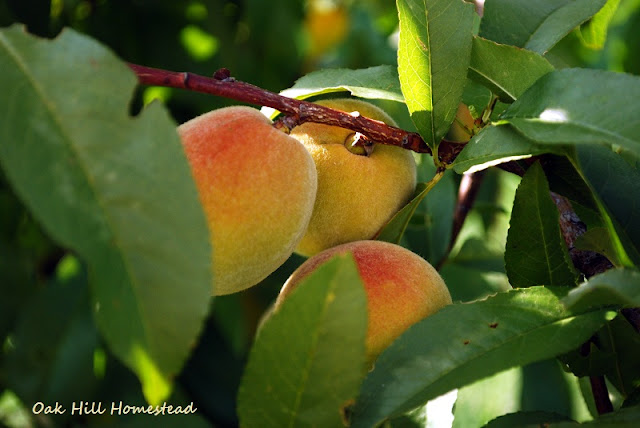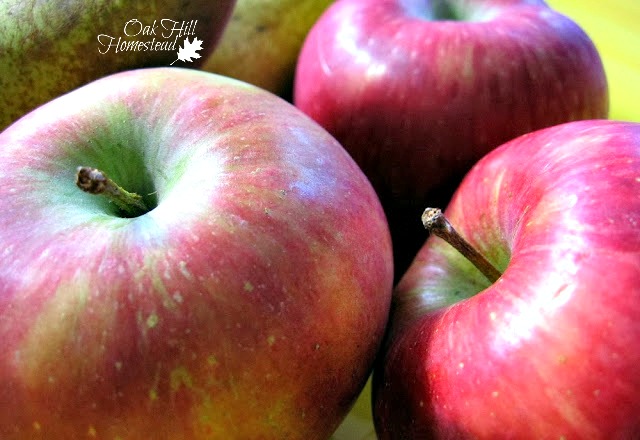There's an old saying, "the best time to plant a tree is 30 years ago. The next best time to plant is today." Learn how to choose fruit trees, decide where to plant them, and how to care for your trees so you'll have a bountiful fruit harvest year after year.
How to plan and plant a homestead orchard
We planted eight dwarf fruit trees the first autumn we lived at Oak Hill.
Planting fruit trees in the fall gives them just enough time for the roots to become established before the cold weather comes that sends the trees into dormancy.
The cooler weather isn't as stressful on the newly-transplanted trees as hot weather is, and they don't have to be watered as often.
By spring your young trees are well-acclimated to their new home and will jump right into spring growth.
You can plant fruit trees in both spring and fall. When planted in autumn, your trees' root systems have a head start when spring arrives the following year. However, spring planting is also fruitful.
We try to plant at least one new tree each year. Not all of them have lived, but we haven't given up.
We research and choose trees that should thrive in our climate.
Which means we haven't planted any apricot trees even though we love apricots. They bloom so early here that the buds are almost always killed by a late Oklahoma frost.
Are you ready to start a homestead orchard? Here is what you need to know about selecting trees, and where and how to plant them.
By the way, 26 homesteaders (including me) and preppers were recently asked what we would plant if we could only plant one food-bearing tree. You might be surprised to learn what the most-recommended tree is.
Dwarf or Standard Trees
Fruit trees are sold in at least three sizes: dwarf, semi-dwarf and standard. This refers to the mature size of the tree.
Dwarf trees mature in a shorter period of time, while standard trees take longer to produce. For an idea of how long it will be before your trees produce fruit, see this post on fast-growing fruit trees.
On the other hand, dwarf trees don't produce for as many years as standard trees do, and you'll have a larger harvest from these larger trees.
Dwarf trees require less space than standard trees.
If I were to do it again, I'd plant both dwarfs and standards. The dwarf varieties would produce first, and would provide fruit before the standard trees began to produce.
When the dwarf trees "run out of gas" the standard-size fruit trees would still be going strong.
Related post: Common Gardening Words and Phrases for Beginners
What Kind of Fruit Should You Plant
If you don't care for apples, don't plant apple trees. That probably goes without saying!
Consider these questions to help you decide:
- What fruit do you enjoy eating?
- Do you love to eat it fresh or will you freeze or can the fruit?
- Does this type of fruit tree grow well in your climate?
- How much space do you have to grow trees?
- Do your trees require a pollinating variety?
Many fruit trees need two different varieties that bloom at the same time in order to pollinate the blossoms and produce fruit on both trees.
Certain varieties are better pollinators than others. Nursery websites such as Stark Bros will suggest varieties that are a good match for the trees you select.
Know Your Garden Zone
Where do you live? It's important to know! Each type of fruit tree has varieties that grow best in certain climates.
You can find your garden zone here at Garden.org. Just enter your zip code in the box and hit enter for the answer.
Use this information when you're choosing your trees from a website or catalog.
Apple trees, for instance, need a certain number of "chill hours" in order to thrive and produce fruit. The further south you live, the more important this information is because of course winter doesn't last as long so there aren't as many chill hours.
You'll find ten varieties of apple trees that grow well in Zones 8-10 in this post.
Choose the Best Location
Fruit trees grow best in full sun and in fertile, well-drained soil.
Be sure to look around your prospective site for utility lines both in the ground and overhead, and for sewer lines, water pipes, buildings or walkways that will be within the mature trees' footprint. Your trees won't stay little for long.
Avoid places where frost will settle, such as the bottom of a slope or a low spot in a field.
Remember that the trees will grow much bigger than their current immature size and locate them where they won't obstruct a view you like or block the sunlight from your garden.
Dwarf trees should be spaced 8-10 feet from each other, semi-dwarf trees 12-15 feet, and standard trees 18-20 feet from another tree.
Planting Tips
Dig a wide hole, twice as wide as the root ball of your tree, and deep enough that the roots will be able to expand easily. Add plenty of good compost to the soil you've removed.
Set the tree in the center of the hole with the roots spread out. Backfill the soil around the tree, being sure to keep the trunk vertical. Put the best soil in the bottom of the hole where it will nourish the roots.
Water thoroughly after planting.
Watering young fruit trees deeply once or twice a week for the first two years will help the tree develop a deep root system and grow into a healthy and productive tree.
What kind of fruit trees will you choose?
If you're planning to have peach, apricot or nectarine trees, do you want freestone or cling stone fruit? Cling stone refers to peaches and other stone fruit that "cling" to the large seed or pit inside. I personally find them hard to work with if I'm trying to can the fruit.
I much prefer freestone fruit. The stone, or seed, separates easily from the fruit and is much easier to work with.
If you're planning to can the fruit from your trees, you might find these posts helpful:
Your guide to preserving apples
How to make harvest apple jelly without added pectin
How to can pears in a water-bath canner
How to preserve fruits, vegetables and more to fill your pantry
For more homesteading and simple living inspiration, sign up to receive my weekly-ish newsletter The Acorn, and follow me on Facebook, Instagram and Pinterest. I'd love to see you there!
~~~~~
My hope is to inspire you, and to encourage your homesteading plans and your dreams of a simple, self-reliant, God-dependent life. You can follow me at:
Facebook | Instagram | Pinterest | Subscribe






















